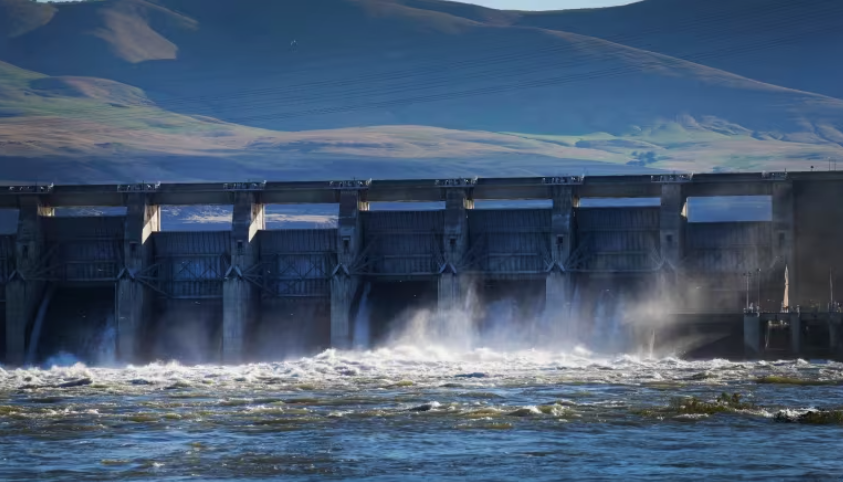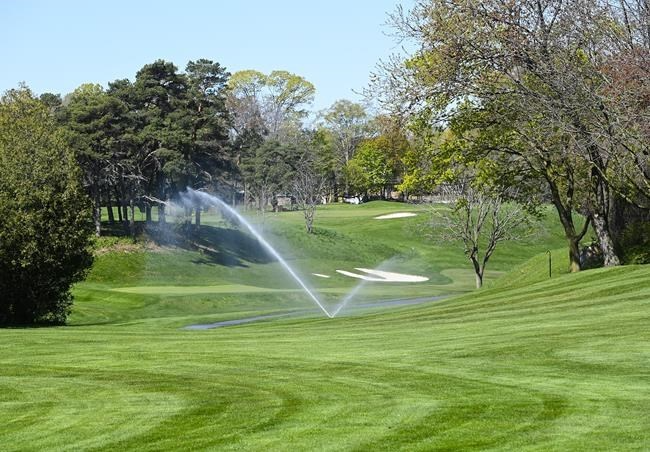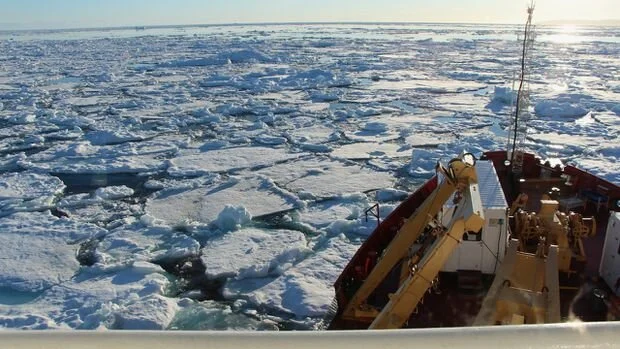Walk along the banks of the Columbia River in B.C. and you might be forgiven for thinking it's like any of the province's other big waterways. You might spot a sturgeon, or glimpse one of the more than 60 dams in the Columbia's watershed. But the Columbia is not like other rivers. For one, it crosses the U.S. border to empty into the Pacific in Oregon. The Columbia River basin is also a vital source of electricity, providing about 40 per cent of all U.S. hydroelectric power, while B.C. draws almost half of its total electrical generation from the region.
Warming waters in the Gulf of St. Lawrence affecting animal life
From great white sharks around Quebec's Îles-de-la-Madeleine to lobsters conquering new territory, oceanographers say the warming of the Gulf of St. Lawrence is having an impact on the creatures that live in its unique ecosystem. Data from Fisheries and Oceans Canada show that deepwater temperatures have been increasing overall in the gulf since 2009. In 2022, gulf-wide average temperatures hit new record highs at depths of 150 to 300 metres, and passed the threshold of 7 C at 300 metres for the first time. Average monthly temperatures at the sea surface also set new records in August and September, the data showed.
These nearly invisible organisms help clean Lake Tahoe's water. Here's how they do it
Plankton are not just a diabolical mastermind on a Nickelodeon show about a sponge who lives under the sea. Lake Tahoe is filled with them—the good kind. Tahoe native zooplankton are making a comeback in the more than 21-mile long lake, helping it look the clearest it has in 40 years. A comeback because until now, the microorganism's population significantly decreased after it's primary predator, the Mysis shrimp, was on the rise, according to previous Sacramento Bee reporting.
City of Brooks asking residents to cut down on water usage
A water shortage has caused the City of Brooks and surrounding area to be put under water rationing. The Eastern Irrigation District (EID) has reported a significant drop in river levels, six to eight weeks earlier than usual due to low snowpack and early snowmelt in the region. In turn, the EID has initiated Stage 3 of their Drought Plan, limiting water usage to two-thirds of normal for residents and businesses in Brooks.
Nature Conservancy of Canada touts plan to protect 5,000 square km of Prairie grasslands
"They provide a lot of what we call ecosystem services," he said. "So, they provide a lot of benefit to everyday Canadians' lives, even if you don't live or work in the grasslands." They store and filter water, preventing both floods and droughts. They improve water quality. They keep soil in place, because of extensive root networks, so there's less erosion along lakes and rivers.
Cleanup, revitalization coming to Whitby, Ont. waterfront
Environmental studies have been taking place at Pringle Creek over the past two decades to determine the extend and risks of chemical contamination to the Whitby, Ont., waterfront. Leanne Lumb-Collett, environmental program manager for the federal Department of Fisheries and Oceans Canada (DFO), said the source of contamination has been traced to a building adjacent from Pringle Creek, and started decades ago.
A 'buffer' against rising seas: How one group is trying to save Metro Vancouver's salt marshes
As the financial costs of climate change climb, experts and governments are quickly coming to the consensus that man-made structures won't be enough to protect coastal communities. For biologist Dan Stewart, the answer is obvious, and on a recent overcast day, he was looking at it: from the edge of the Boundary Bay dike, a more than 200 metre-thick band of salt marsh reached out to the sea.
Nature Conservancy of Canada purchases land for protection in southern Alberta
The announcement comes a few months after the organization announced a $6.9-million campaign to save a 16.5-square-kilometre property called the Yarrow, which is also in southern Alberta but "a little farther north" from the latest project and just outside what's traditionally known as the Waterton Park Front. The Yarrow also features grasslands, wetlands, creeks, mixed forests and includes 27 wildlife species of provincial and national significance. There are two streams that provide fish habitat and transport water from Alberta's southern headwaters to rivers across the Prairies that flow to Lake Winnipeg and eventually Hudson Bay.
CANADA: Canadian golf courses working to reduce ecological impact
Golf's origins date back hundreds of years to rural Scotland where the natural features of the land near Edinburgh created the hazards that golfers had to play around and sheep kept the grass well manicured. But the game has spread around the world in the ensuing centuries with different environments forcing the technology used to maintain golf courses to evolve well past sheep. Golf courses have become divisive with some environmentalists criticizing their use of pesticides and fresh water, but their defenders argue that they can be oases that give cities and suburbs important green space.
BEYOND LOCAL: Freshwater basins drying up increases threat to ecosystem, communities
When people use freshwater beyond a physically sustainable rate, it sets off a cascade of impacts on ecosystems, people and the planet. These impacts include groundwater wells running dry, fish populations becoming stranded before they are able to spawn and protected wetland ecosystems turning into dry landscapes. Developments in computer models and satellites have fostered a new understanding of how freshwater is being redistributed around the planet and have made clear the central role that people play in this change. This human impact is so significant that organizations like the United States Geological Survey are redrawing their water cycle diagram to include the impacts of human actions.
This week’s mailbox: Yukon’s water and John Streicker’s car
Water is essential to life and common to everything that lives. It is our most precious resource and, therefore, needs our protection. This is precisely what Maude Barlow, Canada’s renowned water advocate, has argued for years. In her most recent book, Whose Water Is It Anyway?, she states that a water secure and a water-just future depends upon our adoption of four principles: “1. Water is a human right and an issue of justice and charity; “2. water is a common heritage and public trust and, therefore, access to water must not be allowed to be decided by private, for profit interests; “3. water has rights beyond its service to humans and must be respected and protected for the ecosystem and other living beings; and “4. rather than being a source of conflict and division, water can be nature’s gift to teach us how we might learn to live more lightly on the planet and in harmony with one another.”
'New Brunswick safari': A guided tour of lower Wolastoq wetlands
It was a warm, sunny Aug. 25 morning when we departed from the public slip at Gagetown in a flat-bottomed, aluminum boat. Our guides were three Ducks Unlimited employees: outreach specialist Samantha Brewster and conservation specialist Frank Merrill, both based in Fredericton, and Adam Campbell of the Sackville area, the group's manager of Atlantic operations.
Water temperatures in the Gulf of St. Lawrence have reached record highs, experts warn
New data shows that water temperatures in the Gulf of St. Lawrence have reached record highs, with experts warning the increase could impact some species that live in the waters. According to new research, published Tuesday by Fisheries and Oceans Canada, warming ocean temperatures -- specifically those in deep water -- set more records in the Gulf of St. Lawrence in 2021 than in the past 40 years.
Caretakers of their waterways: Two Nova Scotians granted visionary awards
As you read this, tom cod are pushing through mud-dark water and gathering in the thousands at the head of the Minas Basin. They are driven blindly through the churning turbid water of the world’s highest tides by some ancient memory we can only understand by contemplating the moments we’ve felt instinct grab hold of our own bones. Waiting for them six days a week in an open aluminum boat are Darren Porter and daughter Erica. They’ll be there hauling and downloading the data from receivers, tagging fish and checking for signs of failed struggle until the ice chokes them off the water in January. “When you’ve spent enough time here you start becoming part of the ecosystem,” said Porter.
From wastelands to conservation: Why Alberta needs to start thinking about its wetlands
Tuesday marks the 50th anniversary of an international agreement to protect wetlands around the globe, and this may get you thinking what is so important about wetlands. For awhile they were looked at as wastelands, but over the past few decades, science has shown just how important these areas are. Dan Kraus, a senior conservation biologist with the Nature Conservancy of Canada, says wetlands were the first habitat to have been protected through a global agreement.
Deep water temperatures hit 'scary' highs in Gulf of St. Lawrence
A decade-long warming trend in the Gulf of St. Lawrence continued in 2020 with deep waters reaching record highs, according to ocean climate data released Tuesday by the Department of Fisheries and Oceans. Water temperatures at depths of 200, 250 and 300 metres were higher than any measured in the Gulf since records started in 1915, hitting highs of 5.7 C, 6.6 C and 6.8 C. All were well above the normal variations.
River Talk — Movement grows to build weir/dam across Koocanusa Reservoir
Completed in 1973, the Army Corps of Engineers dam was designed to regulate how spring snow melt in the Kootenay River watershed (87% of which originates in Canada) enters the downstream watershed. It has done so effectively, but at a considerable price to local residents. The upper end of the reservoir in Canada bears the brunt of the storage draw down each spring, and in dry years, the reservoir’s moonscape does not always refill to a level that allows for much recreation. The control over these water levels is 100% vested in American operation of Libby dam.
Sask.'s $4B irrigation plan must address changing climate, Indigenous rights: professor
The Saskatchewan government has announced a $4-billion plan to expand irrigation out of the Lake Diefenbaker reservoir. Work is set to begin immediately, and will be completed in three phases over the next decade. CBC reporter Jason Warick spoke Friday with John Pomeroy, a Canada Research chair and director of the University of Saskatchewan's Global Water Futures program.
Canadian Arctic awash in microplastics, study finds
In the first large-scale survey of its kind in the region, researchers sampled more than 30 locations across the eastern Arctic and Hudson Bay and were able to detect microplastics nearly everywhere they looked, including in surface waters, marine sediments and in the guts of zooplankton – the tiny, floating organisms that occupy the base of the Arctic food chain. And while the long-term effects of the materials on the environment and on human health remain largely unknown, the results suggest widespread exposure is becoming inescapable, even for people living in the most remote areas of the globe.
DFO considers release of toxins to control an invasive species in Miramichi Lake
Officials at Canada's Department of Fisheries and Oceans are weighing in on a troublesome question. Should they allow a healthy lake to be poisoned — even temporarily — to avert a potential disaster for the Miramichi River's wild Atlantic salmon? That question became urgent this fall with the discovery of dozens of smallmouth bass had appeared in Miramichi's southwest branch.





















